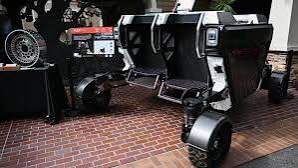Three companies compete for NASA’s next moon rover

Three companies have emerged as contenders for providing NASA’s next Moon rover for crewed missions scheduled later this decade, the space agency disclosed on Wednesday. These companies include Texas-based Intuitive Machines, which successfully landed a robot near the lunar south pole in February, Lunar Outpost of Colorado, and Venturi Astrolab of California. They have been entrusted with developing designs under a contract with a combined maximum potential value of $4.6 billion.
According to NASA’s latest budget request, the US space agency plans to award one of the three companies a “demonstration task order.” This order entails conducting a test run for their Lunar Terrain Vehicle (LTV) on the Moon’s surface before the arrival of crew for the Artemis 5 mission, currently slated for 2030.
Jacob Bleacher, NASA’s chief exploration scientist, expressed enthusiasm, stating, “We are building up the capabilities needed to establish a longer-term exploration and presence on the Moon. I like to imagine the views and the vistas that the LTV will enable us to see from the surface of the Moon.”
Despite the contracts being awarded to relatively new companies, they have formed partnerships with established players in the aerospace industry. For instance, Intuitive Machines has received an initial $30 million to advance its prototype, called the Reusable Autonomous Crewed Exploration Rover (RACER), with collaborators such as AVL, Boeing, Michelin, and Northrop Grumman.
Venturi Astrolab, on the other hand, is developing the Flexible Logistics and Exploration (FLEX) rover in collaboration with Axiom Space and Odyssey Space Research. Astrolab’s contract, potentially worth up to $1.9 billion, aims to create a rover capable of carrying two astronauts, supporting scientific exploration with a robotic arm, performing cargo logistics, and withstanding the extreme temperatures at the lunar South Pole.
Meanwhile, Lunar Outpost has teamed up with industry giants like Lockheed Martin, General Motors, Goodyear, and MDA Space to develop the Lunar Dawn LTV. Justin Cyrus, CEO of Lunar Outpost, stated, “We’re taking cutting-edge technology and automotive industry strengths to provide a true off-road vehicle capable of allowing us to live and work on the surface of the Moon.”
NASA emphasized that it would be procuring services from the companies rather than purchasing their hardware, aligning with a contract model aimed at reducing costs and stimulating a broader space economy. Eventually, the selected company could cater to private sector clients as well.
As part of the Artemis program, named after the sister of Apollo in Greek mythology, the United States aims to return astronauts to the Moon and establish a sustained presence. While the first crewed mission, Artemis 3, is slated for 2026, there are doubts regarding the feasibility of this timeline. In the backdrop of a burgeoning space race, China also plans to send a crew to the Moon by 2030, intensifying global space exploration efforts.
